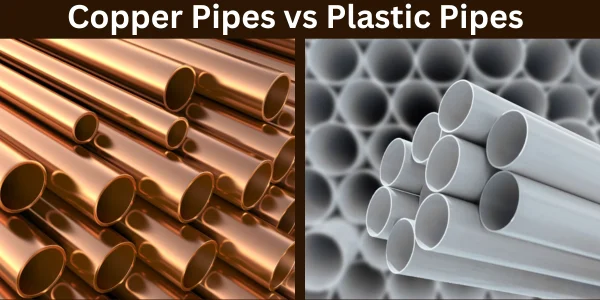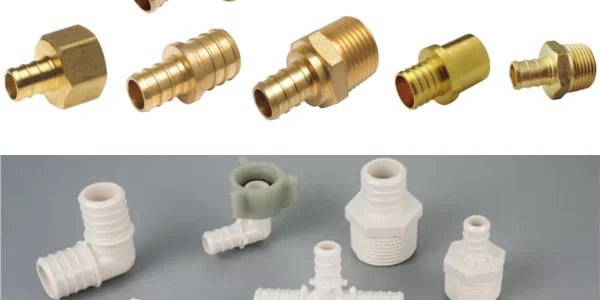When choosing between copper pipes and plastic pipes for your plumbing system, it’s crucial to understand the pros, cons, and ideal applications for each material. Both types have distinct features that make them suitable for various plumbing needs. This guide will help you decide which option best fits your home’s plumbing requirements.
Copper Pipes Overview
Copper pipes have been a popular choice in plumbing for decades due to their durability and reliability. These pipes are made from copper, a strong and corrosion-resistant metal.
Advantages of Copper Pipes
- Durability and Longevity
- Copper pipes are highly durable and can last for over 50 years when properly maintained. They resist corrosion better than many other materials, especially in indoor environments.
- Heat Resistance
- Copper pipes can withstand high temperatures, making them ideal for hot water supply lines.
- Bacteria Resistance
- Copper has natural antimicrobial properties that inhibit the growth of bacteria inside the pipes, ensuring clean water flow.
- Environmentally Friendly
- Copper is a recyclable material, making it an eco-friendly plumbing option.
- Fire Resistance
- Unlike plastic pipes, copper pipes are non-combustible, providing added safety in case of a fire.
Disadvantages of Copper Pipes
- Higher Cost
- Copper pipes are more expensive than plastic pipes, both in terms of material and installation costs.
- Corrosion in Certain Conditions
- While copper is corrosion-resistant, acidic water or extreme environmental factors may cause damage over time.
- Potential for Metal Leaching
- In rare cases, copper pipes can release small amounts of copper into the water, particularly in new installations.
- Rigid Structure
- Copper pipes are less flexible than plastic pipes, making them harder to install in tight spaces.

Plastic Pipes Overview
Plastic pipes are available in different types such as PEX (cross-linked polyethylene), PVC (polyvinyl chloride), and CPVC (chlorinated polyvinyl chloride). Each type has unique characteristics that suit specific plumbing needs.
Advantages of Plastic Pipes
- Cost-Effective
- Plastic pipes are generally more affordable than copper pipes, both in terms of material and installation costs.
- Flexible and Lightweight
- PEX pipes are highly flexible, making them easier to install, especially in tight corners and complex layouts.
- Corrosion and Chemical Resistance
- Plastic pipes resist corrosion, scaling, and damage from chemical exposure.
- Noise Reduction
- Plastic pipes minimize water hammer noise, ensuring quieter plumbing systems.
- Efficient Installation
- Plastic pipes often require fewer fittings, reducing installation time and complexity.
Disadvantages of Plastic Pipes
- Lower Heat Resistance
- While CPVC can handle hot water, standard PVC is not suitable for high-temperature applications.
- Less Durable
- Plastic pipes have a shorter lifespan than copper pipes and may degrade faster when exposed to UV light or extreme temperatures.
- Potential for Leaks at Joints
- Plastic pipes may require additional sealing solutions to prevent leaks at connection points.
- Environmental Impact
- Unlike copper, plastic is not as eco-friendly due to its manufacturing process and limited recyclability.
Key Factors to Consider
When deciding between copper and plastic pipes for your plumbing system, consider these important factors:
1. Cost
- Copper pipes are generally more expensive than plastic pipes.
- Plastic pipes are budget-friendly and easier to install, saving both material and labor costs.
2. Lifespan
- Copper pipes can last for 50+ years, whereas plastic pipes usually have a lifespan of 25-40 years.
3. Water Quality
- Copper pipes provide cleaner water with minimal chemical leaching.
- PEX and CPVC are safe for drinking water but may require extra precautions in extreme conditions.
4. Installation
- Copper pipes require skilled soldering, while plastic pipes are easier to cut, connect, and secure using push-fit fittings or crimp rings.
5. Environmental Impact
- Copper is recyclable, reducing environmental concerns.
- Plastic pipes are lightweight but less sustainable due to their chemical production.
6. Temperature Tolerance
- Copper pipes excel in extreme heat conditions.
- PEX and CPVC are ideal for colder climates due to their freeze-resistant properties.
Best Use Cases
When to Choose Copper Pipes
- For homes with high-temperature water systems.
- In areas where fire resistance is a priority.
- When long-term durability is a primary concern.
When to Choose Plastic Pipes
- For cost-effective installations and budget-conscious projects.
- In regions with colder climates or where flexibility in piping layout is essential.
- When ease of installation and minimal maintenance are key.
Conclusion
Both copper and plastic pipes have their strengths and weaknesses. Copper pipes offer superior durability, heat resistance, and reliability, making them ideal for long-term use. On the other hand, plastic pipes provide affordability, flexibility, and easier installation, making them popular for modern plumbing solutions.
If you’re looking for a reliable solution with long-term benefits and budget is not a concern, copper pipes may be your best choice. Conversely, if you prefer a cost-effective, flexible, and easy-to-install option, plastic pipes are an excellent alternative. Consulting a professional plumber can help you make the best decision based on your home’s specific plumbing requirements.

